DJI (company)
 | |
 DJI Phantom 4 Pro | |
| DJI | |
Native name | 大疆创新科技有限公司 |
| Private | |
| Industry | |
| Founded | 2006 |
| Founder | Frank Wang (Wāng Tāo) |
| Headquarters | Shenzhen, Guangdong, China |
Area served | Worldwide |
| Products | |
| Revenue |
|
Number of employees | c. 6000[2] (2017) |
| Divisions |
|
| Subsidiaries | Hasselblad |
| Website | dji.com |
Dà-Jiāng Innovations (doing business as DJI) is a Chinese technology company headquartered in Shenzhen, Guangdong with manufacturing facilities throughout the world. It is known as a manufacturer of unmanned aerial vehicles (UAV), commonly known as drones, for aerial photography and videography. DJI also design and manufacture camera gimbals, flight platforms, cameras, propulsion systems, camera stabilizers, and flight control systems.
DJI is the world's leader in commercial and civilian drone industry, accounting for over 70% of the drone market.[3] Its drone technology has been used globally for the music, television and film industries, including K-pop music videos and the sets of Emmy Award-nominated television productions such as The Amazing Race, American Ninja Warrior, Better Call Saul, Game of Thrones, and many more.[4][5][6][7][8][9]
In 2017, DJI won a Technology & Engineering Emmy Award for its camera drone technology, which was recognized for excellence in engineering creativity, providing directors and cinematographers an affordable and accessible platform to create low-altitude aerial images, opening up creative possibilities and facilitating the distinct looks of some TV shows.[10]
History

The company was founded in 2006 by Frank Wang (Wāng Tāo, 汪滔).[11]
Wang, who hails from China’s Zhejiang Province, went to Hong Kong in 2003 after enrolling for a degree course in Hong Kong University of Science and Technology (HKUST). Two years later, the university granted him HK$18,000 (US$2,300) to conduct research and develop a drone. Wang founded the company in 2006 from his dorm room at HKUST.
DJI’s name stands for Dà-Jiāng Innovations, but it used to mean Dà-Jiāng Sciences.[12]
DJI manufactures a range of products including unmanned aerial vehicles, flying platforms, flight controllers for multi-rotors, helicopters accessories, aerial and handheld gimbals and ground stations.[13][14][15][16] These products are intended for amateur as well as professional use.[17][18] DJI product is sold directly on DJI's website as well as through Authorized DJI Dealers around the world.
Products
Flight
Controllers
DJI develops flight controllers intended for multi-rotor stabilization control of various platforms or heavy payloads in aerial photography. The A2 controller includes orientation, landing, and home return features. Products include GPS-Compass receivers, LED indicators and Bluetooth connectivity.[19][20]
| Model | A2 | Naza V2 | Wookong-M | Naza-M Lite |
|---|---|---|---|---|
| Number of Motors Compatible | 4–8 | 4–8 | 4–8 | 4–6 |
| Has Built-in Receiver | Yes (2.4 GHz) | No | No | No |
| Hovering Accuracy (m) | Vertical: ± 0.5m / Horizontal: ± 1.5m | Vertical:±0.8m / Horizontal:±2.5m | Vertical: ± 0.5m / Horizontal: ± 2m | Vertical:±0.8m / Horizontal:±2.5m |
| Motor/ Rotor Configuration | Quad-Rotor: +4,X4; Hex-Rotor: +6,X6,Y6,Rev Y6; Octo-Rotor: +8,X8,V8 | Quad-rotor: I4, X4; Hex-rotor: I6, X6, IY6, Y6; Octo-rotor: I8,V8,X8 | Quad-Rotor: +4,X4; Hex-Rotor: +6,X6,Y6,Rev Y6; Octo-Rotor: +8,X8,V8 | Quad-rotor I4, X4; Hex-rotor I6, X6, IY6, Y6 |
Platforms
Ronin
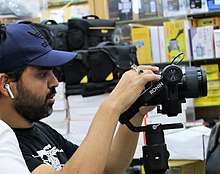
The Ronin (如影) is a standalone ground-based camera platform developed for cinematography and aerial filmmaking in professional environments. It is built for professional videography and photography and targets the film industry. By using three individual motors, Ronin stabilizes when moving vigorously.[21] Later models of the Ronin include the Ronin M and the Ronin 2.
Modules
DJI offers several add-on modules for their base products such as power management and video modules.
| Module | Lightbridge | PMU (A2, Wookong, Naza V2, Naza Lite) | iOSD MARK II | iOSD mini | BTU |
|---|---|---|---|---|---|
| Type (Purpose) | Video Downlink | Power Management | On-Screen Display | On-Screen Display | Bluetooth Link |
| Works With | A2, Wookong-M, Naza V2 | A2, Wookong-M, Naza V2, Naza-M Lite | A2, Wookong-M, Naza V2 | A2, Wookong-M, Naza V2 | Naza V2 |
| Interface | CAN Bus | CAN Bus, Battery Connection | CAN Bus | CAN Bus | CAN Bus |
| Battery Requirements | 4S-6S Lipo | 4S-12S Lipo | 4S Lipo and Shared Flight Controller Power | 2S Lipo and Shared Flight Controller Power | Shared Flight Controller Power |
UAVs
Flame Wheel
The Flame Wheel (风火轮) series are multirotor platforms for aerial photography. As of 2016, there is the hexacopter F550, and quadcopters F330 and F450. The most recent is the ARF KIT.[22][23]
| Model | Flame Wheel F330 | Flame Wheel F450 | Flame Wheel F550 |
|---|---|---|---|
| Diagonal wheelbase (cm) | 33 | 45 | 69 |
| Frame weight (g) | 156 | 282 | 478 |
| Take-off weight (g) | 600 – 1200 | 800 – 1600 | 1200 – 2400 |
Phantom
.jpg)
The Phantom[24] (精灵) series are DJI's consumer flagship quadcopters. They are currently the most popular product, and since launch, have evolved to integrated flight programming with a camera, Wi-Fi or Lightbridge connectivity, and the pilot’s mobile device.[25] Phantoms are made for aerial cinematography and photography applications,[26] but are also used in recreational use.[27]
There have now been four generations of the product line, each increasingly more capable.[28][29] The most recent one is the Phantom 4 Advanced, announced on April 18, 2017.[30]
| Model | Phantom 1 | Phantom 2 | Phantom 2 Vision | Phantom 2 Vision+ | Phantom FC40 | Phantom 3 Standard | Phantom 3 4K | Phantom 3 Advanced | Phantom 3 Professional | Phantom 3 SE | Phantom 4 | Phantom 4 Pro | Phantom 4 Advanced |
|---|---|---|---|---|---|---|---|---|---|---|---|---|---|
| Diagonal wheelbase (mm) | 350 | 350 | 350 | 350 | 350 | 350 | 350 | 350 | 350 | 350 | 350 | 350 | 350 |
| Height (m) | 0.19 | 0.19 | 0.19 | 0.19 | 0.19 | 0.19 | 0.19 | 0.19 | 0.19 | 0.19 | 0.19 | 0.19 | 0.19 |
| Power consumption (W) | 3.12 | — | — | — | 3.12 | — | — | — | — | — | — | — | |
| Take-off weight (g) | < 1200 | < 1300 | 1180 | 1284 | 1200 | 1216 | 1280 | 1280 | 1280 | 1280 | 1380 | 1388 | 1368 |
| Max speed (m/s) | 10 | 15 | 15 | 15 | 10 | 16 | 16 | 16 | 16 | 16 | 20 | 20 | 20 |
| Endurance (min) | — | 25 | 25 | 25 | 10 | 25 | 25 | 23 | 23 | 25 | 28 | 30 | 30 |
| Rate of climb/descend (m/s) | 6 | 6/2 | 6/2 | 6/2 | 6 | 5/3 | 5/3 | 5/3 | 5/3 | 5/3 | 6/4 | 6/4 | 6/4 |
| Operating temperature (°C) | - 10 to 50 | - 10 to 50 | — | — | - 10 to 50 | 0 to 40 | 0 to 40 | 0 to 40 | 0 to 40 | 0 to 40 | 0 to 40 | 0 to 40 | 0 to 40 |
| Maximum altitude (m) | 6000 | 6000 | 6000 | 6000 | 6000 | 6000 | 6000 | 6000 | |||||
| Maximum range (m) | 1000 | 4000 | 5000 | 7000 | 7000 |
Mavic
.jpg)
The Mavic (御) series currently includes Mavic Pro and Mavic Air, both have foldable design that allow drones to be transported more easily.[31]
The Mavic Pro is introduced on September 27, 2016. It features multiple redundant sensors and obstacle avoidance to help prevent crashes.
| Model | Mavic Pro | Mavic Air | Mavic 2 Pro | Mavic 2 Zoom |
|---|---|---|---|---|
| Maximum Speed (Sport mode, no wind) | 40 MPH / 65 km/h / 18.0 m/s | 42.5 MPH / 68.4 km/h / 19.0 m/s | 45 MPH / 72 km/h / 20 m/s | 45 MPH / 72 km/h / 20 m/s |
| Maximum Speed (P-Mode) | 22 MPH / 35 km/h / 9.7 m/s | 15.5 MPH / 25 km/h / 6.9 m/s | 30 MPH / 48 km/h / 13.4 m/s | 30 MPH / 48 km/h / 13.4 m/s |
| Maximum Speed (WiFi only mode) | 9 MPH / 14 km/h / 3.9 m/s | -- | -- | -- |
| Empty weight (grams) | 734 (without gimbal cover) / 743 (with gimbal cover) | 430 (without gimbal cover) | 907 (max takeoff weight) | 905 (max takeoff weight) |
| Flight time | ~27 Mins | ~21 Mins | ~31 Mins | ~31 Mins |
| Realistic flight time | ~21 Mins | ~16 Mins | ~29 Mins | ~29 Mins |
| Operating temperature (°C) | 32° to 104 °F (0° to 40 °C) | 32° to 104 °F (0° to 40 °C) | 14° to 104 °F (-10° to 40 °C) | 14° to 104 °F (-10° to 40 °C) |
| Range (with controller) | 4.3 miles / 7 km, 2.2 miles / 3.5 km with CE controller. | 2 kilometers with CE controller | 5 miles / 8 km | 5 miles / 8 km |
| Range (with WiFi only) | 262 feet/ 80 meters | -- | -- | -- |
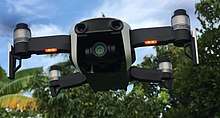
The Mavic Air was announced on 23 January 2018, for release on 28 January. It is marketed as a smartphone-sized drone that can fit in a jacket pocket.
It features a 12 MP 4K HDR camera, mounted on a 3-axis gimbal, and has a new panorama mode, which stitches together 25 photos in eight seconds to create a "Sphere Panorama". Due to antennas mounted on its landing gear, the drone has a 21-minute flight time and a 2.5 mile range. Like the Spark, the Air also features the "Smart Capture" mode, in which the drone can be controlled by hand gestures.[32]
Spreading Wings
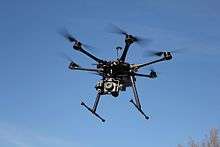
The Spreading Wings (筋斗云) series are mainly industrial UAVs for professional aerial photography, high definition 3D mapping, ultra light search and rescue, and surveillance etc. based on camera gear on board. In 2013, two models have been released: S800 regular and EVO.[33]
| Model | Spreading Wings S800 | Spreading Wings S800 EVO | Spreading Wings S900 | Spreading Wings S1000 |
|---|---|---|---|---|
| Diagonal wheelbase (cm) | 80 | 80 | 90 | 104.5 |
| Empty weight (kg) | 2.6 | 3.7 | 3.3 | 4.2 |
| Take-off weight (kg) | 5 – 7 | 6 – 8 | 4.7 – 8.2 | 6 – 11 |
| Endurance (min) | 16 | 20 | 18 | 15 |
| Operating temperature (°C) | — | — | - 10 to 40 | - 10 to 40 |
Inspire
.jpg)
The Inspire (悟) series is a professional series of camera quadcopters similar to the Phantom line, but including more high-end and professional features including an aluminum-magnesium body with carbon fibre arms, and detachable props on the Inspire 2. Presented in 2017, the Inspire 2 can be equipped with a 6K camera that is capable of capturing up to 30 FPS.[34]
Inspire Specifications [35]
| Model | Inspire 1 | Inspire 1 Pro | Inspire 2[36] |
|---|---|---|---|
| Weight | 2935 g (Battery included) | 3400 g (Battery, propellers and Zenmuse X5 included) | 3440 g (Battery, propellers and camera on-board) |
| Takeoff Weight | 3400 g | 3500 g | 4000 g |
| Hovering Accuracy
GPS mode |
Vertical: 0.5 m; Horizontal: 2.5 m | Vertical: 0.5 m; Horizontal: 2.5 m | Vertical: 0.5 m; Horizontal: 1.5 m |
| Max Angular Velocity | Pitch: 300°/s; Yaw: 150°/s | Pitch: 300°/s; Yaw: 150°/s | Pitch: 300°/s; Yaw: 150°/s |
| Max Tilt Angle | 35° | 35° | 35° |
| Max Ascent/Descent Speed | 5/4 m/s | 5/4 m/s | 5/6 m/s |
| Max Speed | 22 m/s (ATTI mode, no wind) | 18 m/s (ATTI mode, no wind) | 24 m/s (ATTI mode, no wind) |
| Max Flight Altitude | 4500 m | 4500 m | 4500 m |
| Max Wind Speed Resistance | 10 m/s | 10 m/s | 10 m/s |
| Operating Temperature Range | -10°−40 °C | -10°−40 °C | -20°−40 °C |
| Max Flight Time | Approximately 18 minutes | Approximately 15 minutes | Approximately 27 minutes |
| Indoor Hovering | Enabled by default | Enabled by default | Enabled by default |
| Release Date | November 13, 2014 | January 5, 2016 | November 16, 2016 |
Matrice
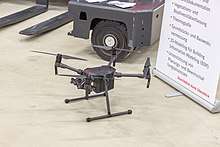
The Matrice (经纬) series are designed for industrial applications.
The Matrice 100 is a fully programmable and customizable drone, launched on July 6, 2015.[37] It has expansion bay and communication ports, which allows developers to add additional components for different purposes. [38]
Matrice 200 series is a range of weatherproof quadcopters from DJI announced in February 2017.
They are designed for industrial applications, including surveying, inspection, search and rescue and firefighting.[39]
The highest spec of the series is the Matrice 210 RTK, which features Real Time Kinematic technology, allowing for precise Geotagging of images captured from the quadcopter.[40]
The Matrice 200 only supports a single camera, mounted either below or above the drone.
The Matrice 210 and 210 RTK add the ability to dual mount cameras to the drone, allowing multiple sensors to be used simultaneously.[41]
Spark
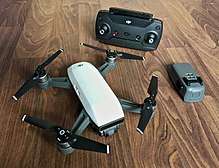
Released in May 2017, the Spark (晓) was designed to be an affordable consumer drone that is nevertheless capable of producing high-quality images and video. This drone is DJI's cheapest to date and features a 12-megapixel camera capable of shooting 1080p video at 30fps. The camera is stabilised mechanically by a 2-axis gimbal. The Spark also carries an advanced infrared 3D camera that helps the drone to detect obstacles in front of it, as well as facilitating hand-gesture control—a feature that was, until the release of the Mavic Air in January 2018, unique to the Spark. In addition to a smartphone app with virtual controller, a physical controller can also be bought, extending the drone's range up to 1.2 miles (2 km). The aircraft has a flight duration of up to 16 minutes, but its exhausted battery can easily be swapped out for a charged battery to extend flight time.[42]
There have been multiple complaints that the drone could switch off and fall while flying[43]. DJI responded to this by releasing a mandatory battery firmware update in August 2017.[44]
Camcorders
Osmo
The Osmo (灵眸) is a camcorder developed by DJI. The camera uses a smartphone to view camera footage and can record 4K and take either 12–16 MP stills. The camera is interchangeable, with the Zenmuse X3, X3 Zoom, X5, and X5R gimbals compatible, and uses the FM-15 Flexi microphone.
Osmo Mobile
Similar to the Osmo, it instead relies on the user's smartphone as the camera. Most smartphones are accepted into the gimbal with a width range of 2.31–3.34 inch (58.6-84.8 mm). The original Osmo Mobile has reached its end-of-life and has been replaced with a second generation.[45]
Osmo Mobile 2
Announced after CES, the DJI Osmo Mobile 2 is the successor to the original Osmo Mobile. Still reliant on a smartphone camera, the Osmo Mobile 2 was a refinement adding multiple shot modes and increasing the battery life to 15 hours. With the rise of Instagram Stories, the Osmo Mobile also allows the gimbal to be placed in portrait mode.[46][47]
Goggles
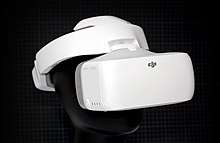
The DJI Goggles [48] are comfortable goggles designed for FPV flying with DJI products. They combine a pair of screens, wireless connectivity, and direct control of photo and video capture. In November 2017, DJI presented a new, so-called 'Racing Edition' [49].
Market trends
As of March 2017, DJI has a 50 percent market share of the consumer drone market according to NPD numbers. Top line estimates from the FAA point towards the number of consumer drones hitting over 4 million units by 2021.[50][51][52]
Controversy
In January 2015, a DJI Phantom 3 crashed into the White House's south lawn, in Washington, D.C..[53] DJI later set up a no-fly Geo-system according to prohibited airspace, and forced all drones to update the firmware. The new system will forbid flights getting closer or take off in restricted zones based on its GPS location.[54]
Several military organizations also utilize DJI products for aerial photography mission including the US Army, and DJI drones were the most widely used commercial unmanned aerial system that the US Army has employed. However, on August 2017, the United States Army published internal guidance regarding the banning of using DJI drones and parts in the army for security reasons. DJI’s Public Relations Manager, Michael Perry expressed surprise and disappointment after the memo was released. A U.S. Army spokesperson responses to media and claim that the guidance is still undergoing a review.[55] Although US Army has stopped using DJI products, other branches of the US military such as the US Marines are still fielding DJI product as commercial photography platform.[56]
On November 17, 2017, Ars Technica reported a security breach of private customer data at DJI.[57]
See also
References
| Wikimedia Commons has media related to DJI (company). |
- ↑ "Drone-maker DJI to develop more industry applications - Chinadaily.com.cn". Jan 27, 2018. Retrieved Jan 30, 2018.
- ↑ "ABOUT DJI".
- ↑ "World's top drone seller made $2.7 billion". January 3, 2018.
- ↑ "Up: A Chinese firm has taken the lead in a promising market". The Economist. 11 April 2015. Retrieved 19 April 2015.
- ↑ "DJI, Qianxun partnership to promote the BeiDou system - Business - Chinadaily.com.cn". www.chinadaily.com.cn.
- ↑ "SlashGear's Best of IFA 2017". SlashGear. 1 September 2017.
- ↑ "DJI & K-Pop Powerhouse Zanybros Form Strategic Partnership". AsiaOne.
- ↑ Schroth, Frank (31 August 2017). "DJI Wins 2017 Emmy for Technology and Engineering". DRONELIFE.
- ↑ Fitzpatrick, Alex. "The DJI Spark Is The First Drone I Actually Want To Buy". Time.
- ↑ Schroth, Frank (31 August 2017). "DJI Wins 2017 Emmy for Technology and Engineering". DRONELIFE.
- ↑ Colum Murphy and Olivia Geng (November 10, 2014). "Q&A: Chinese Drone Founder Explains Why Steve Jobs Is His Role Model". The Wall Street Journal. Retrieved March 2, 2015.
- ↑ "10 Things You Probably Didn't Know About DJI". Uplift Drones. June 20, 2018.
- ↑ Farhad Manjoo (December 31, 2014). "Standouts in Tech: Drones, Virtual Reality, Instant Translation and A.I." New York Times. Retrieved March 2, 2015.
- ↑ Helen Regan. "Watch the Latest Must-Have Smart Toys Unveiled at Asia's Largest Toy Fair". Time. Retrieved March 2, 2015.
- ↑ Tom Duening. "A Hot Seller in a Hot Market: Meet the World's Most Successful Seller of Drones". Flying Cameras. Retrieved March 2, 2015.
- ↑ "Quadcopter 4K - Featuring 4K Drone Video by Quadcopters with Cameras". Quadcopter 4K. Retrieved March 2, 2015.
- ↑ "DJI Products". DJI Technology. Retrieved March 2, 2015.
- ↑ Jack Nicas (November 12, 2014). "Chinese Drone Maker DJI Unveils More Powerful Model". The Wall Street Journal (WSJ). Retrieved March 2, 2015.
- ↑ "The A2 model". DJI Technology. Retrieved March 2, 2015.
- ↑ "DJI Naza-H Helicopter Gyro System w/ GPS". Helipal. Retrieved March 2, 2015.
- ↑ "The A2 model". OXM HOFFMAN 360. Retrieved March 2, 2015.
- ↑ "Flame Wheel ARF Kit". DJI Technology. Retrieved March 2, 2015.
- ↑ "FYFT M5 series blimps". DJI Technology. Retrieved March 2, 2015.
- ↑ "Phantom series". Flying Cameras. Retrieved March 2, 2015.
- ↑ Personal Tech (September 10, 2014). "An Eye in the Sky, Accessible to the Hobbyist: A Teardown of the Phantom 2 Vision Plus Drone from DJI". The New York Times. Retrieved March 2, 2015.
- ↑ "DJI Phantom Released". Retrieved March 2, 2015.
- ↑ "2016 DJI Phantom 3 Standard Review | New Lower Price". What Are The Best Drones?. Retrieved 2016-04-19.
- ↑ Chase Sutton. "DJI Phantom 2 Vision+ Review and Manual". DroneLifestyle. Retrieved March 2, 2015.
- ↑ "DJI Phantom 3 vs Phantom 2 comparison". Drones Den. June 15, 2015. Retrieved June 19, 2015.
- ↑ "DJI Phantom 4 Advanced – Specs, FAQ, Tutorials and Downloads". DJI Official. Retrieved 2017-04-13.
- ↑ "DJI Mavic Pro vs GoPro Karma in a Drone Spec Shootout". News Ledge. October 4, 2016.
- ↑ Heater, Brian. "DJI's $799 'smartphone-size' Mavic Air drone starts shipping January 28". TechCrunch. Retrieved 2018-01-23.
- ↑ "Spreading-Wings s1000 Plus". DJI Technology. Retrieved March 2, 2015.
- ↑ Murison, Malek. "DJI Has Decided That The Inspire 2 is Too Fast". dron life. Retrieved 8 May 2017.
- ↑ "DJI Inspire 1 & Inspire 1 Pro Specifications". HoverShotz Aerial Drone Photography, Video and Inspections Cumbria. 2017-01-16. Retrieved 2017-05-16.
- ↑ http://www.dji.com/inspire-2/info#specs Drone Best
- ↑ Matrice 100 release history DJI
- ↑ "MATRICE 100: an advanced quadcopter for developers". My Drone Lab. Retrieved 20 March 2018.
- ↑ "DJI Matrice 200 Series". Heliguy. Retrieved 12 September 2017.
- ↑ "DJI Matrice 210 RTK". Heliguy. Retrieved 12 September 2017.
- ↑ "DJI Matrice 200 Series Payload Options". DJI. Retrieved 12 September 2017.
- ↑ "DJI Spark is a Selfie Drone for the Masses". News Ledge. 2017-05-24. Retrieved 2017-05-30.
- ↑ People are complaining that their new DJI Spark drones are falling out of the sky — Quartz
- ↑ "DJI Spark Firmware Update Enhances Flight Safety". DJI Official. Retrieved 2017-09-30.
- ↑ "Osmo Mobile Specs". DJI.
- ↑ "DJI Osmo Mobile 2 – Smartphone Gimbal – DJI". DJI Official. Retrieved 2018-09-10.
- ↑ "Shutter Release: How to Choose the Best Vlogging Cameras of 2018". News Ledge. 2017-06-08. Retrieved 2018-09-10.
- ↑ "DJI Goggles". DJI.
- ↑ "DJI Racing Edition Goggles". Drone Addicts.
- ↑ "Consumer Drones By the Numbers in 2017 and Beyond". News Ledge. 2017-04-04. Retrieved 2017-07-08.
- ↑ Glaser, April (2017-04-14). "DJI is running away with the drone market". Recode. Retrieved 2017-07-08.
- ↑ "Fact Sheet – FAA Forecast–Fiscals Years 2016-37". www.faa.gov. Retrieved 2017-07-08.
- ↑ "Drone maker DJI bans Washington flights after White House crash". BBC. Retrieved 2018-01-24.
- ↑ "FLY SAFEGEO-ZONE MAP". DJI. Retrieved 2018-01-24.
- ↑ [https://www.suasnews.com/2017/08/us-army-calls-units-discontinue-use-dji-equipment/>US Army calls for units to discontinue use of DJI equipment</a> - sUAS News. 4 August 2017
- ↑ The U.S. Military Shouldn’t Use Commercial Drones - slate. August 2017
- ↑ "DJI left private keys for SSL, cloud storage in public view and exposed customers".